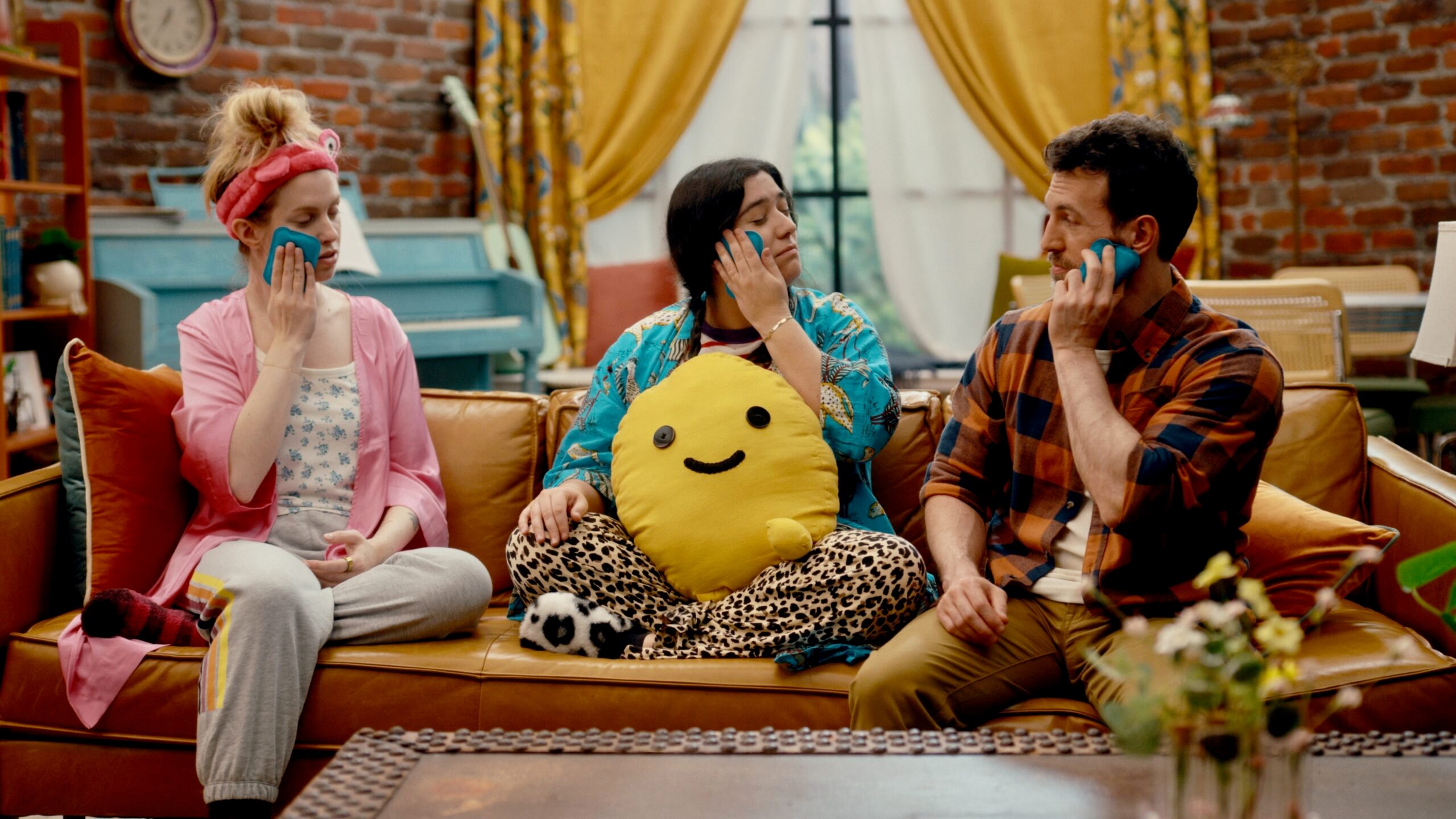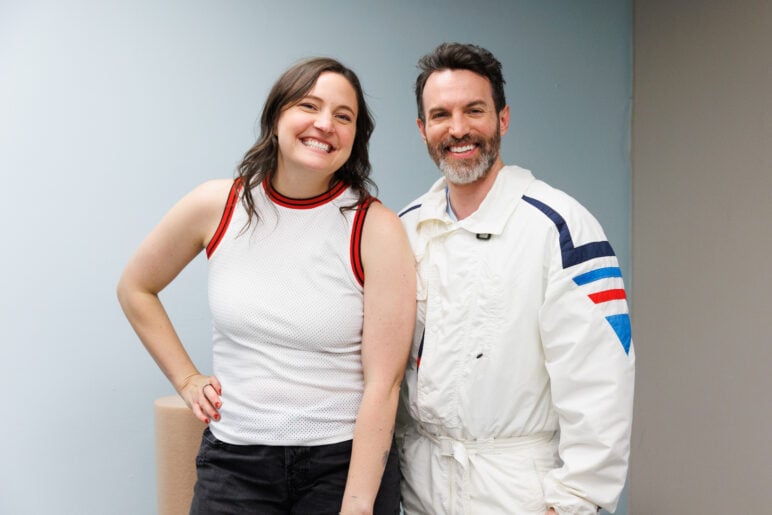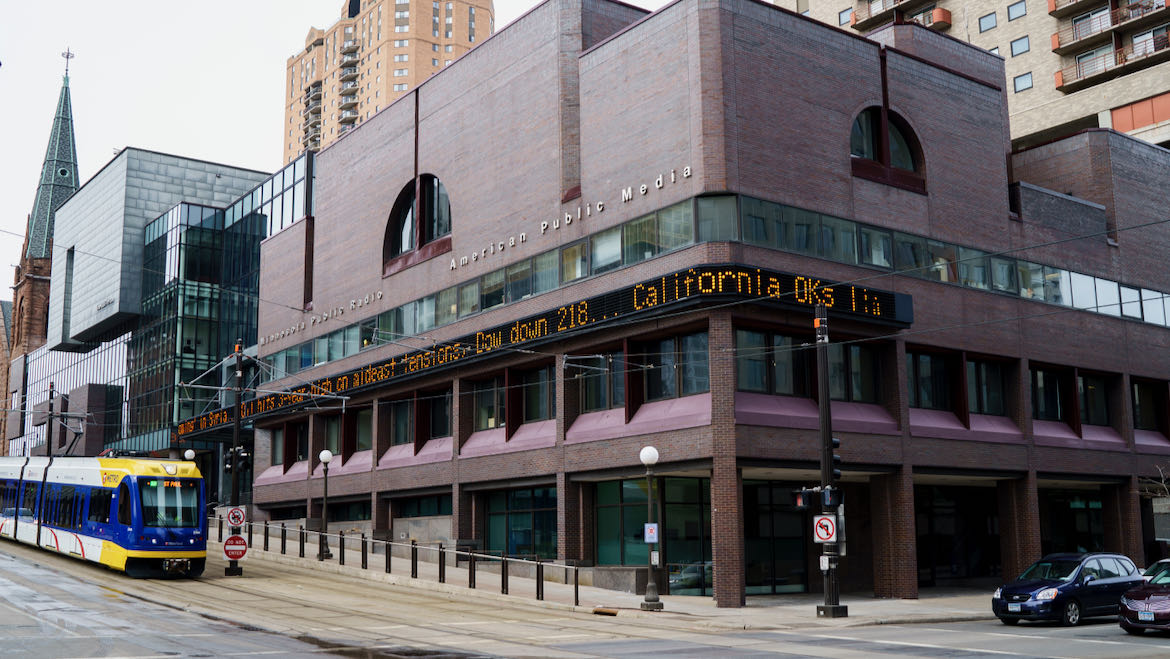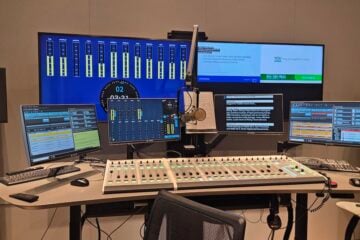How a new public TV sitcom is helping viewers talk about mental health

How Are We Today?
On an episode of "How Are We Today?", Tyler, right, and his neighbors Barbara and Mariel hold ice packs on their faces, a technique for managing their emotions.
A new public TV show uses humor and the hallmarks of sitcoms to help viewers open up about struggles with mental health conditions.
Inspired by shows like Sesame Street and Mister Rogers’ Neighborhood, How Are We Today? debuted Sept. 13 on Texas’ Austin PBS and was made available on the PBS App two days later. Twenty PBS stations in markets such as New York, Los Angeles, Chicago and the U.S. Virgin Islands are airing the show.
In the premiere of the show’s seven-episode first season, Tyler Coe — the show’s creator, producer, writer and lead actor, playing a fictionalized version of himself — moves into a new apartment. Looking into the camera, he discusses how stressful relocating can be, then plays piano to calm his nerves.
Due to hypomania associated with his bipolar disorder, Tyler doesn’t realize that he’s been tapping away on the keys for hours, well into the night. His new neighbors, Barbara and Mariel, knock on his door and politely ask him to stop. Tyler uses this opportunity to invite them inside so he can break down his struggles with bipolar disorder. How Are We Today? depicts Tyler’s manic episodes by showing him going on an extravagant shopping spree, winning a prize, becoming a celebrity, and then jumping off a cliff.
The show’s second episode explores the character of Tyler’s sister and her worry that her daughter is struggling with depression. Later installments revolve around other characters — including a puppet, Barry the Beaver — and their own concerns.
The way Coe addresses the viewer is reminiscent of Fred Rogers, LeVar Burton and Bill Nye. But his apartment looks like Monica’s in Friends, and the camaraderie in How Are We Today? is a more supportive and nonjudgmental version of the interaction among the hit NBC show’s characters.
Coe says he wanted to ensure that How Are We Today? used the half-hour sitcom format to explore “mental health issues in an educational, fun and dynamic way” while appealing to modern audiences unfamiliar with other public TV shows.
KENW in Portales, N.M., is among the stations that have picked up the show. Director of Programming Sean Moore says the show’s unique approach to mental health topics caught his attention. Not only did How Are We Today? fit perfectly into a wellness block programmed in-house for a KENW subchannel, it was a timely reminder that people “never grow out of the need for empathy and kindness,” Moore says.
Combining experience and science
Formerly a host for ESPN Radio, Electronic Arts, PlayStation and the comedy channel Rooster Teeth, Coe drew inspiration for How Are We Today? from decades of experience with his own mental health challenges. Misdiagnosed at the age of 13 and put on harmful medication, Coe struggled with substance abuse and attempted suicide several times before getting help.
By 2019, he was intent on sharing his mental health journey in a powerful way. He started a podcast, also titled How Are We Today?, to gauge audience interest. He got positive responses and briefly considered making How Are We Today? into an animated series before pivoting to live-action during COVID.

The third episode of Coe’s podcast featured a guest who is now the resident psychologist for How Are We Today? At the time, licensed clinical psychologist Erin Newins was working at Dell Children’s Hospital in Austin and was trying to figure out how to deliver mental health care to people who wouldn’t normally have access to it. She saw that How Are We Today? could give her a bigger platform to spread her message.
“Most often when we think about mental health, it’s really dark, when in normal life it’s usually just something like ‘School or work sucks,’ then we move on from it,” Newins says.
Coe says that from the beginning, he wanted How Are We Today? to combine genuine experiences of mental health conditions with easy-to-understand advice for viewers experiencing similar problems. Coe knew he could depict the experiences, but when he spoke to Newins, he recognized that she could explain the science behind the conditions and share coping lessons in an accessible manner.
“When I had Dr. Erin on my podcast, I could immediately see that she was able to talk about mental health problems in a simple way and connect with people,” Coe said. “It just blew me away. I knew that needed to be the heartbeat of the show.”
In each episode of the TV show, Newins helps a person struggling with a mental health condition by explaining what they’re going through and giving them advice on how to handle it. She says she was attracted to How Are We Today? because it shows how friends can “stumble upon a mental health conversation over dinner in a funny, quirky, tongue-in-cheek way and then move on. The show pauses in that moment, which is where the magic happens in therapy.”
As well as being fascinated by Coe’s approach, Newins says she wanted to clear up the “misinformation, bad stereotypes, confusion, stigma and negativity surrounding mental health,” particularly because people looking for help can be overwhelmed by options.
“One of the biggest problems is, how do we get the right information in the right way to the right people?” Newins says. “What we wanted to do with this show is make the science evidence-based and bring legitimate psychology and information to people in a way that feels fun.”
South Florida PBS recently picked up How Are We Today? for its Health Channel. Penelope Douglas, director of content and acquisitions for the channel, says she hopes the show will encourage viewers to come forward and discuss their own mental health issues and concerns.
“Mental health can be a pretty heavy topic, and it’s very stigmatized,” Douglas says. “It can be scary for people to talk about it. We hope viewers will see how the different conditions like ADHD and depression are discussed on the show and they’ll feel more comfortable bringing up the subject at the appropriate time.”
“It’s a lot easier to say, ‘Hey, I saw this show on TV and a teenage girl was acting really different from the way she used to act and her mom is really worried about her’ than it is to bring up a topic like depression just out of the blue,” Douglas adds.
Funding challenges
Despite Coe’s clear vision and original approach, finding funding for How Are We Today? has been a major fight over the last six years. “It’s taken years off my life,” Coe says. While his character on the show often tries to find the best in the world, Coe had to be a version of himself that he didn’t like when searching for funding. “I’ve gone kicking and screaming through this process,” Coe says. “I’ve not handled it with grace.”
After hearing Coe’s pitch for How Are We Today? in 2022, Austin PBS “immediately” agreed to serve as the show’s presenting station and distribution partner, says COO Sara Robertson. The station was impressed by the concept and approach, which Robertson says was “different from anything I’d seen done in public media.” The show is distributed by American Public Television.
Austin PBS signed a three-year deal for exclusive broadcast rights for the show but was unable to provide any funding. Coe and fellow producers Cameron Berkman and Lauren Salatich reached out to numerous organizations but struggled to find support. Coe admits that it was hard to keep spirits high but says the denials were a constant reminder of the importance of shows like How Are We Today?
“It encouraged me at times to be like, ‘This is why I have to keep going,’” he says.
Ultimately, Coe and his team were able to secure funding from technology company Emerson and Lady Gaga’s Born This Way Foundation, as well as through individual donations from family and friends.
By the start of 2024, How Are We Today? had amassed just enough money to film. Director Hannah McCarthy and other cast and crew members worked for free or used paid time off from other jobs to help. Throughout filming, they told Coe how worthwhile the show was. “It just made it feel important and that we were doing something really meaningful,” Coe says
Coe and his team turned to Kickstarter earlier this year to raise postproduction funds and brought in $58,445. “It was insane that it actually happened,” Coe says. After the show’s trailer amassed over 10,000 views on YouTube, Coe was delighted to read the comments and see that many people were supportive.
“One said, ‘When I watched the trailer, at first I rolled my eyes, then by the end I was crying,’” Coe says. “Others just said this show is something they needed to watch. It blew us away.”
A descendant of Mister Rogers
After seeing the trailer, affiliates started to pick up the show. Jean-Pierre García, television program manager at Northwest Public Broadcasting in Pullman, Wash., said that when he saw the clip, he couldn’t help but smile and think, “Yes, this is what public media is all about.”
Moore adds that How Are We Today? feels like a continuation of classic public TV shows. “I hope grown-up viewers can get the same sense of belonging they used to get from Mister Rogers when they were kids,” he writes in an email. “There is a continuity with a program like this for those of us who grew up watching Mister Rogers and still watch Public TV. Programs like this exemplify the value of Public Television.”
Now that How Are We Today? is airing, Coe says producers have already received an email from a small university in California asking how it can support the science behind the show. A PR agency has been working for free to organize interviews, and plans are in motion to create PBS LearningMedia materials. The show’s team has written a second season but still lacks funding.
Coe is hopeful that having episodes available to watch helps but knows that nonprofits are closing their wallets. That hasn’t stopped him from trying to get How Are We Today? in front of as many people as possible. Last month he even spoke about the show and its message at the impact lounge at the United Nations General Assembly. With the future of the show out of their hands, Coe and the rest of the cast and crew are coping with a mindfulness strategy they learned while shooting.
“When something happens in your world, are you going to react to it impulsively, or are you going to respond to it with your values? We have to keep in mind the message we want to portray and the people we want to be,” Newins says. “Ultimately, that’s what this show is about. There’s a lot of pain and harm going on in the world. Our idea is, ‘What are we going to do with that?’ What we want to do is create something beautiful, meaningful and helpful.”
Correction: An earlier version of this article incorrectly referred to “How Are We Today?” as a PBS show. It is distributed by American Public Television.





